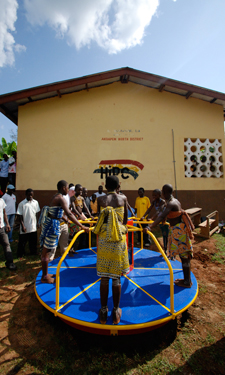 On many playgrounds, the energy produced by children spinning the merry-go-rounds or powering the teeter-totters just translates into friction that wears down the equipment over time. But some innovative companies are developing ways to capture this kinetic energy and put it toward useful purposes for the surrounding community. The engineers who pioneered this technology hope it spreads so playgrounds can be legitimate sources of power in more communities around the globe.
On many playgrounds, the energy produced by children spinning the merry-go-rounds or powering the teeter-totters just translates into friction that wears down the equipment over time. But some innovative companies are developing ways to capture this kinetic energy and put it toward useful purposes for the surrounding community. The engineers who pioneered this technology hope it spreads so playgrounds can be legitimate sources of power in more communities around the globe.
Since 2008, a Utah-based nonprofit called Empower Playgrounds Inc. (EPI) has established 40 electricity-generating merry-go-rounds throughout the West African country of Ghana, with 10 more planned for 2013. In the off-grid Ghanaian communities where EPI has built playgrounds, most children have to work after school on family farms or complete other chores until after dark each day when they can no longer see well enough to complete their schoolwork. EPI playgrounds, produced in partnership with Playworld Systems, are built primarily to supply renewable battery-stored power to lanterns, which the children can bring home at night to help them further their education. A love of play along with a strong will to learn keeps the lights burning night after night. In addition, each installation, which costs about $10,000, comes with a science kit that helps teach the students about the physics involved, providing multiple lessons from a system they can experience for themselves.
“We have seen high levels of use with the systems, and they become an integral part of society as the village takes ownership of the program,” says EPI CEO Chris Cannon. “So far, all of our installations have been in Ghana, but we are beginning to explore partnerships with other nonprofits and organizations that would include other countries with similar needs.”
“We believe play and education are both vital to the human experience, regardless of geography, age, or ability,” adds Matthew Miller, CEO of Playworld Systems. “We’re ecstatic to work with Empower Playgrounds to help enrich the lives of others in such a profound and innovative way.”
Other charitable groups around the world have experimented with similar projects in Africa, though none to the same extent as EPI. A company called PlayPumps rolled out a merry-go-round that pumped clean well water for a few test communities in South Africa, but the organization has since closed its doors due to impractical long-term planning. Similarly, United Kingdom-based PlayMadeEnergy piloted an energy-generating seesaw, dubbed the Energee-Saw, and successfully installed a few prototypes throughout Uganda and Malawi. Unfortunately, due to the discontinuation of a key third-party product component, the company halted operations in 2011.
However, other companies throughout the world have had greater success. Last year in the United Kingdom, The Great Outdoor Gym Company (TGO) built a concept outdoor fitness center at a park in the East Yorkshire city of Hull that helps demonstrate the energy it takes to power modern society. As the first TGO Green Energy gym, the Green Heart at Shaw Park features four energy-generating pieces of equipment—a hand bike, a cross trainer, a fitness bike, and a recumbent bike—that provide enough energy to power its own lighting, extending the hours the gym is available for use. Although the prototype cost $100,000 to install, subsequent systems may cost as little as $40,000. This January, TGO launched a new series of outdoor gyms, named “e gyms,” based on the Shaw Park pilot.
“The philosophy behind TGO’s drive to bring these products to the market stems from the energy imbalances in the world,” explains Georgie Delaney, TGO’s creative director. “In the west, we tend to have food in abundance and then have to work it off in a gym. Traditionally in an indoor gym, this consumes even more energy through the electricity used for the equipment to run, plus the heating, lighting, TV, etc.
“TGO realized that we have this abundance of human energy all around us, with people trying to keep fit,” Delaney continues. “TGO designed the TGO Green Energy gyms and now e gyms to try and harness some of this energy, generating the energy through exercise and then using it for good in other areas.”
Closer to home, U.S. nonprofit Global Inheritance has developed a traveling energy-producing playground that helps users understand just how much energy their daily lives require. With gliders, human hamster wheels, an energy-capturing dance floor, and more, the Energy Playground makes appearances at schools, festivals, and workplaces around the world, using the generated electricity to power everything from snow-cone machines to concert equipment.
Offering much more than just electricity, from fitness opportunities to educational lessons to pure play, these energy-generating playgrounds have the potential to take off and affect the lives of people around the globe. But the ones that are in place now are clearly already making a significant difference in the lives of their users. Taylor Brown, EPI’s director of media, relays a conversation she had with a young student in a community in Ghana. “Once, when the merry-go-round needed a bit of maintenance, a young woman, about 12 years old, approached me with concern and asked, ‘My sista, we would like to know....When will the merry-go-round be back so that we can have light again?’”
Danielle Taylor is Associate Editor of Parks & Recreation.

